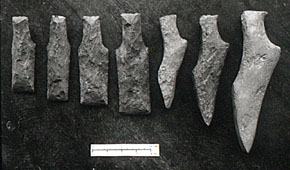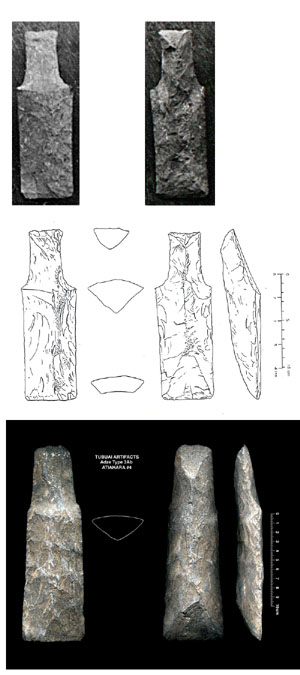Artifacts recently recovered from ATIAHARA #4
I have been searching this site for years now, after each new ploughing I scour the same ground, and find less and less it seems. In the first few years I could count on finding dozens of adze fragments as well as a sprinkling of complete tools, not to mention fishhooks and assorted pearl shell artifacts and fragments, now 15 years later I will be lucky to find an adze fragment at all, I reason that I have recovered almost everything however there is always a chance of finding small things and or the more optimistic theory being that whatever I find now is older material that is being scraped up from the lowest layers, layers that are just beyond the plow zone.
Arriving on the site on this occasion I noticed that the ploughing had been done differently from most seasons running crosswise and furrowing deeply on the western edge, I walked in about 75 meters from the road where the midden is blackest and started collecting basalt flakes all the way back to the limits of the ploughing say 120 meters deep, here the midden is thinning. On the return to the 75 meter mark I found a small coffin shaped adze in excellent condition, complete with just a hint of grinding otherwise unfinished, encrusted with calcareous deposits it appears ancient

This adze form was a common early type in the Moa Hunter period, some specimens are associated with the Wairau Bar burials and may thus be 800 years old or older. Of course finding a complete adze is a great reward after so much looking and I was now in an alert looking mode. I circled the findspot and then within the next few meters pulled up, as if by magic, a large 3A adze, only a bit if the blade tip showing above ground.

this unfinished masterpiece was very similar to an adze I found here 10 years before. At that time I had heard that workers had also found adzes and so traced them down only to discover that many of them were almost identical in form although varied in size with two types represented 3A and 4A, certainly these adzes were made by the same highly skilled artisan and were probably cached together.

.

A close examination of this recent find reveals that it is an older model without the distinct shoulders of the cached example which is otherwise of a very similar size. It would appear that the early Moa Hunter Type 3 adzes also lacked distinct shoulders, they were mainly shallow and merged with the Duff Type 3B (1956) which was untanged. It seems likely that a chronological progression/evolution can be assumed with the earliest models being shallow and untanged which then become progressively thicker and develop distinct shoulders as well as a better defined posterior ridge. Duff points out that the early adzes were actually of a more sub triangular section, the backs forming a continuous curve, the posterior ridge being eliminated by grinding... it would be interesting to know if this transition from untanged to tanged could be linked to the first Moa Hunter settlements, thus we might be able to fix an approximate date for the age of untanged examples.
see page two of Discoveries 2003
page/link INDEX
*****
file INDEX
*****
Artifact INDEX - Vol. 17 - Vol. 18 - Vol. 25




